
If you like this, please support it at Lego Ideas: https://ideas.lego.com/projects/96810
Classic Sega Arcade Machines made with Lego bricks! Perfect for any Lego City arcade! As an old school Sega fan, these games have the quintessential "Sega" feel. Simple yet challenging gameplay, colorful and interesting graphics, and most of all, they're just fun to play.
I originally wanted to create 5 cabinets: these three plus Hang On and After Burner. However, I've been so busy with family, work, and other hobbies that it took nearly half a year of on and off building just to finish these. I figured it's about time to show them, yes?
Out Run
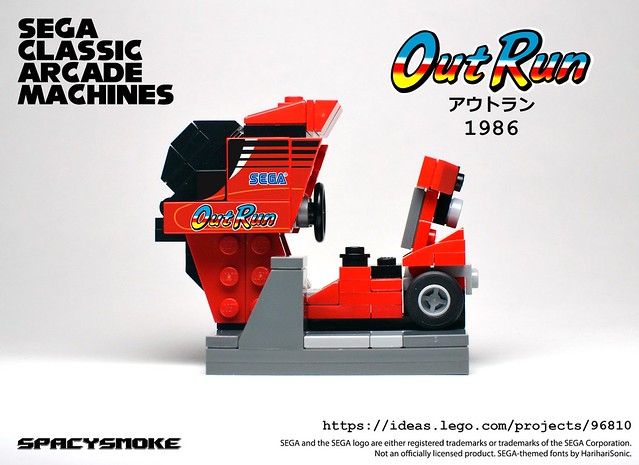
Sega's Out Run came out in 1986 and has been a long time favorite of mine. The game is iconic to me on many levels; the music, the graphics, the gameplay, the Sega-ness of it all...it's just perfect.
This was the first arcade cab I worked on for this series and I worked on it on and off for months trying different ways to build it. It's still not very close to the real thing, and I'm still thinking of ways to improve it. I'm talking mostly about the front section; the real thing is much slimmer than this.
The stickers were custom made in Photoshop and Illustrator. The Out Run logo was found off the web and the Sega logo was created using a font by HariHariSonic.
BTW, all of the stickers in these photos are virtual; they were applied in Photoshop.
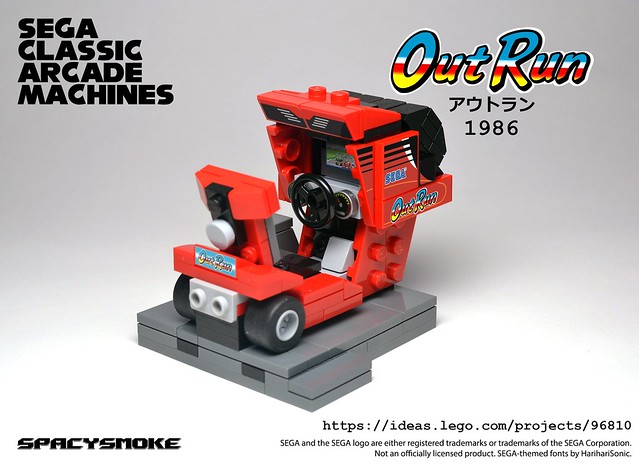
Some Out Run cabinets have this little step on the side. I decided to include it since you can easily remove it if you don't like it.
The screen for this cab is on a 1x2x1 brick. Not ideal, but there wasn't enough room to put a 2x2 tile in there and still have all the current dimensions.
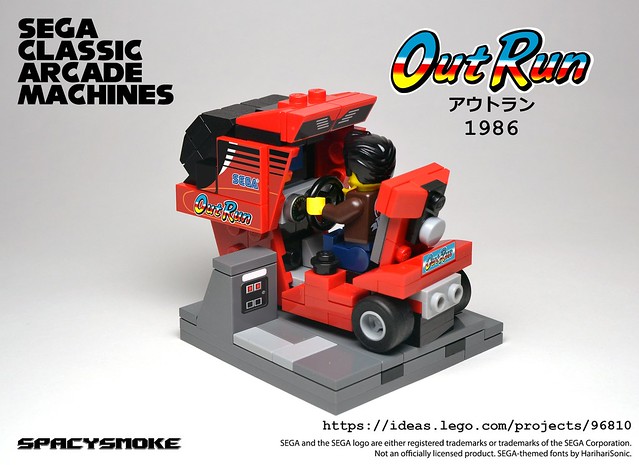
This is how a minifig looks playing the game. I kept going back and forth on whether the coinop device should be 2 studs wide vs. 1 stud wide. Neither is accurate as it should be somewhere between that. Eventually I decided on 2 studs wide because I felt the coinop panel on the sticker should be larger than 1 stud wide.
This photo also shows how the cabinet can rotate left and right to approximate the movement of the real arcade machine.
Thunder Blade

Thunder Blade was the second unit I worked on. I thought it would be easy because it's such a simple design compared to the others. The problem was scale. If I added in all the details of the real unit, it became too tall. So I had to remove some things to shorten it down to something closer to minifigure scale.
The helicopter skids took a while to get right and I finally hit on this solution after other tries didn't work. Other methods were too big, too fragile, or too small. This one was the closest to the scale I wanted to achieve.

The model is pretty stable. The chair is probably the most fragile thing though. It's mounted on half of a 2x2 turntable plate. It could be stronger with an extra plate in there, but I felt that it added too much height to an already tall model.
Like the Space Harrier cab, the screen here is on a 2x2 tile, so it can be switched out with other screenshots.
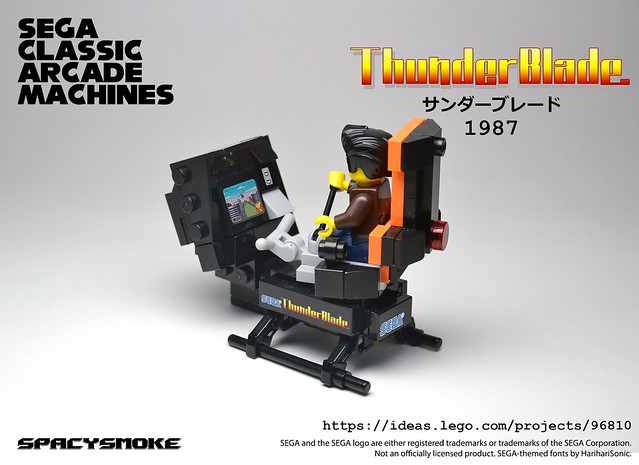
Here's how the build looks with a minifigure. Obviously, the foot rest is kind of useless, but it's there for accuracy.
You can also see how the chair swivels like the real thing.
Space Harrier

This was the third cabinet I worked on. I nearly gave up on it after a couple of failed attempts to build the front and seat sections. I took a break from it and tried to build Hang On, but that didn't go well either, so I came back to this.
I decided to start from scratch and start with the basics: just study the dimensions and details of the real thing for a long time. I figured the front section would be 4 studs wide, the middle would be 3 (with SNOT sides) and the seat would be 2 (also with SNOTted details). This led to the use of some technic beams to add support to the weak 3-stud to 2-stud connection. Once I built the floor of the actual cabinet (the red and white section) and the seat, everything came together really quickly. In fact, I think I took less time on this than the other two.
The front section was a bit of a pain though. There aren't any Lego bow pieces that have the same curvature of the arcade cabinet, and I didn't want to use hinges because I wanted smooth sides to make stickering easier, so this brick-built approximation is what I came up with.
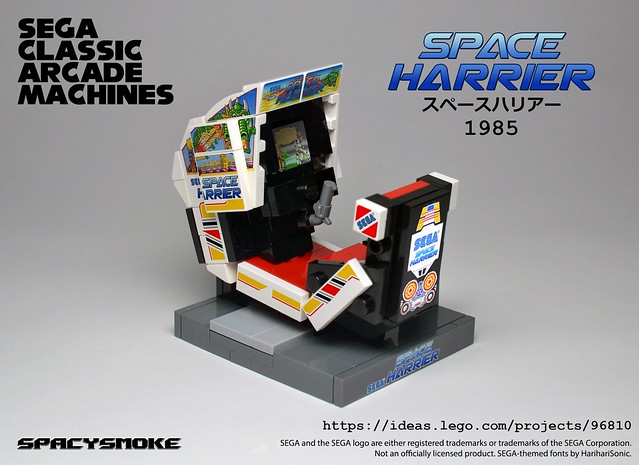
Connecting the front section to the floor was another issue I had to deal with. At first I simply used hinged bricks to attach it, but because it's a 4-studs wide piece connecting to a 3-stud wide floor, I could only connect the two section by just 2 studs (offset). This was too weak for me even though it looked fine. So I redesigned it to use a combination of technic pieces and clicky joints. This worked really well because it's connected to the technic substructure and it's really strong. The only con is the clicky joint is visible at the back of the cabinet. I'm fine with the tradeoff.
Stickering was hell for this one. First, finding good source material was difficult. There really aren't many good shots of the Space Harrier cabinet artwork out there on the interwebs. I even searched in multiple languages. Eventually I found some photos that I had to manipulate in photoshop to create the stickers of the dragon and the back "jets". All the rest I created in Illustrator and had to customize to the dimensions of the Lego pieces. The fonts come from HariHariSonic. Sadly, his site is 404 right now.
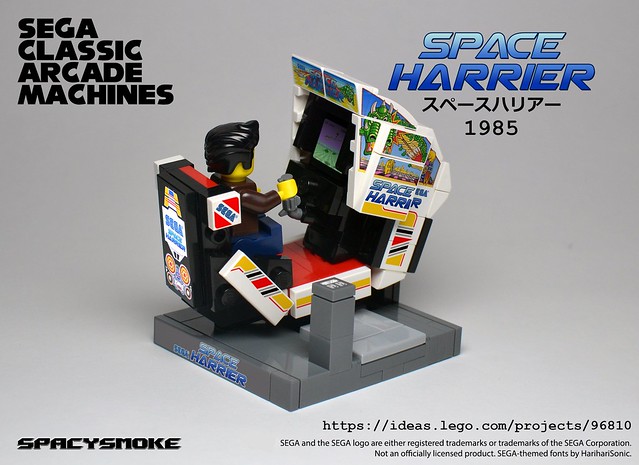
Here, you can see how a minifigure will look at the controls. A minifigure can't actually grab the control stick; that's just a camera perspective trick.
This picture also shows how the cabinet can turn and tilt. It's mounted to the floor using the new ball joints.
Minifigures
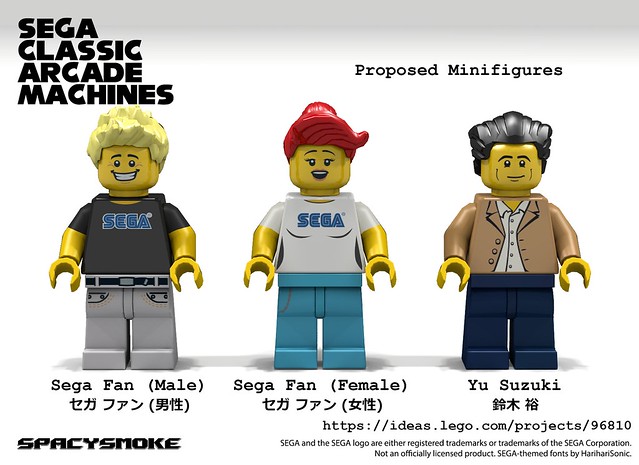
The proposed minifigures for this project. I had originally wanted Ryo Hazuki from Shenmue to be included, but I felt that was just another license they would have to get if this project passes review.
Yu Suzuki is the Sega game designer responsible for Space Harrier, Out Run, Hang On, After Burner, Virtua Fighters, Shenmue and many other iconic Sega games.
That's it for now! I want to continue with the series and may try to tackle After Burner next.
Thanks for looking!



